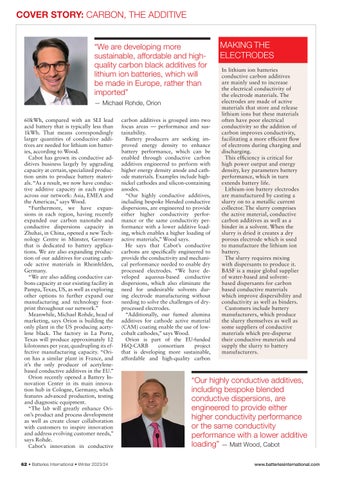COVER STORY: CARBON, THE ADDITIVE “We are developing more sustainable, affordable and highquality carbon black additives for lithium ion batteries, which will be made in Europe, rather than imported” — Michael Rohde, Orion 60kWh, compared with an SLI lead acid battery that is typically less than 1kWh. That means correspondingly larger quantities of conductive additives are needed for lithium ion batteries, according to Wood. Cabot has grown its conductive additives business largely by upgrading capacity at certain, specialized production units to produce battery materials. “As a result, we now have conductive additive capacity in each region across our network: Asia, EMEA and the Americas,” says Wood. “Furthermore, we have expansions in each region, having recently expanded our carbon nanotube and conductive dispersions capacity in Zhuhai, in China, opened a new Technology Centre in Münster, Germany that is dedicated to battery applications. We are also expanding production of our additives for coating cathode active materials in Rheinfelden, Germany. “We are also adding conductive carbons capacity at our existing facility in Pampa, Texas, US, as well as exploring other options to further expand our manufacturing and technology footprint throughout our network.” Meanwhile, Michael Rohde, head of marketing, says Orion is building the only plant in the US producing acetylene black. The factory in La Porte, Texas will produce approximately 12 kilotonnes per year, quadrupling its effective manufacturing capacity. “Orion has a similar plant in France, and it’s the only producer of acetylenebased conductive additives in the EU.” Orion recently opened a Battery Innovation Center in its main innovation hub in Cologne, Germany, which features advanced production, testing and diagnostic equipment. “The lab will greatly enhance Orion’s product and process development as well as create closer collaboration with customers to inspire innovation and address evolving customer needs,” says Rohde. Cabot’s innovation in conductive 62 • Batteries International • Winter 2023/24
carbon additives is grouped into two focus areas — performance and sustainability. Battery producers are seeking improved energy density to enhance battery performance, which can be enabled through conductive carbon additives engineered to perform with higher energy density anode and cathode materials. Examples include highnickel cathodes and silicon-containing anodes. “Our highly conductive additives, including bespoke blended conductive dispersions, are engineered to provide either higher conductivity performance or the same conductivity performance with a lower additive loading, which enables a higher loading of active materials,” Wood says. He says that Cabot’s conductive carbons are specifically engineered to provide the conductivity and mechanical performance needed to enable dry processed electrodes. “We have developed aqueous-based conductive dispersions, which also eliminate the need for undesirable solvents during electrode manufacturing without needing to solve the challenges of dryprocessed electrodes. “Additionally, our fumed alumina additives for cathode active material (CAM) coating enable the use of lowcobalt cathodes,” says Wood. Orion is part of the EU-funded HiQ-CARB consortium project that is developing more sustainable, affordable and high-quality carbon
MAKING THE ELECTRODES In lithium ion batteries conductive carbon additives are mainly used to increase the electrical conductivity of the electrode materials. The electrodes are made of active materials that store and release lithium ions but these materials often have poor electrical conductivity so the addition of carbon improves conductivity, facilitating a more efficient flow of electrons during charging and discharging. This efficiency is critical for high power output and energy density, key parameters battery performance, which in turn extends battery life. Lithium-ion battery electrodes are manufactured by casting a slurry on to a metallic current collector. The slurry comprises the active material, conductive carbon additives as well as a binder in a solvent. When the slurry is dried it creates a dry porous electrode which is used to manufacture the lithium ion battery. The slurry requires mixing with dispersants to produce it. BASF is a major global supplier of water-based and solventbased dispersants for carbon based conductive materials which improve dispersibility and conductivity as well as binders. Customers include battery manufacturers, which produce the slurry themselves as well as some suppliers of conductive materials which pre-disperse their conductive materials and supply the slurry to battery manufacturers.
“Our highly conductive additives, including bespoke blended conductive dispersions, are engineered to provide either higher conductivity performance or the same conductivity performance with a lower additive loading” — Matt Wood, Cabot www.batteriesinternational.com
